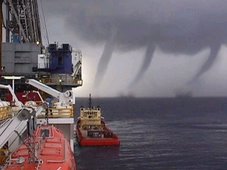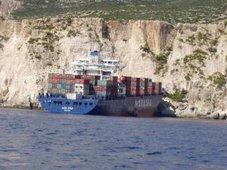 Computers Determine When To Stop Searches For Missing People At Sea
Computers Determine When To Stop Searches For Missing People At SeaScienceDaily (Nov. 27, 2008) — British researchers are developing a new computer model to predict how long someone will survive when lost at sea, which will in turn determine when a search and rescue operation may be stopped.
The Search and Rescue Survival Model is being developed by the University of Portsmouth’s Sports Science and Mathematics departments and the US Coast Guard.
It aims to support the US Coast Guard target of saving 93 per cent of victims annually - between 3000-6000 people - whose lives are in danger at sea.
“Using this new computer model will take pressure off humans making very emotional and sensitive decisions about when to end a search,” said Professor Mike Tipton, human and applied physiologist, from the University of Portsmouth.
“When the model predicts that a victim can no longer survive, the search and rescue team can stop or redeploy the search.
“It will ensure that Coast Guard personnel are not exposed to the high risks associated with search and rescue operations any longer than necessary and will also help to save time and resources,” he said.
The US Coast Guard currently uses a software system known as SAROPS (Search and Rescue Optimal Planning System) to calculate how far a person will have drifted and how large the search area should be.
Data such as wind speed, sea state and water temperature is entered into SAROPS along with information about the victim’s sex, height, weight and what they were wearing to determine exactly how the search should be conducted.
“Calculating survival time will add another layer to SAROPS; it will be able to predict not only where a search should be conducted but when it should be stopped,” said Professor Tipton.
Chris Turner, Ocean Engineer and Manager for the project for the US Coast Guard in Groton, Connecticut, sought the help of the university because of its international reputation for expertise in the area of survival in the sea.
“The University of Portsmouth has been able to tap into and analyze data held by the Institute of Naval Medicine and the Royal National Lifeboats Institution, both critical to the development of this survival model. To our knowledge no other similar repository of this information exists - even in the US.
“The development of this technology is very exciting. It will be trialled in American waters in late 2009 and once thoroughly tested, the aim is to roll it out to the whole of the US,” he said.
WEATHER NOTEWeather disasters claimed 15,000 lives, report says
Stevie Emilia, The Jakarta Post, Poznan, Poland
More than 15,000 people across the world died last year from extreme weather, which also caused US$80 billion in damages, a report released Thursday at the ongoing UN climate change talks here revealed.
The Global Climate Risk Index 2009 by the environment and development group Germanwatch puts Bangladesh at the top of the list of countries most affected by weather-related disasters last year.
Bangladesh, which suffered heavily from cyclone Sidr that killed more than 4,000 people and caused $10 billion in damages, was followed by North Korea and Nicaragua.
Sven Harmeling, the group's senior advisor for climate and development, and author of the study, said many people had been severely affected by storms, floods and other weather extremes.
"People in less-developed countries have a far harder time coping with such events compared with their peers in industrialized countries," he said.
Hurricane Katrina caused $215 billion in damages when it devastated the U.S. Gulf Coast three years ago, making it the most expensive storm in history.
While no single weather disaster can be directly attributed to global warming, Harmeling warned the changing climate would most certainly lead to an increase in their frequency and intensity in many parts of the world.
The UN's Intergovernmental Panel on Climate Change earlier warned that climate change this year was likely to make extreme weather events more frequent and possibly more intense too.
Germanwatch, which first calculated the global climate risk in 2006, derived data for the present study from a database compiled by German insurance giant Munich Re.
The report analyzes how severely countries were affected in 2007 and in the past decade, or from 1998-2007, by weather-related events, including floods, heat waves and storms. It excluded droughts or sea-level rises -- long-term events that are harder to evaluate.
In the latest report, a total of 1,066 disasters were registered last year, causing 15,240 fatalities and economic losses of over $70.1 billion.
Indonesia came in at seventh place on the Down 10 list of countries with the highest death tolls, recording 470 deaths last year, and was ranked eight in the list of Down 10 countries with highest absolute losses, with a total of $3.09 billion.
"We're witnessing a strong increase in disasters, particularly the climate-related ones, in terms of the number of disasters, economic damage and people affected," said Maarten van Aalst, associated director of the Red Cross/Red Crescent Climate Center in The Hague.
"This is partly due to rising vulnerability, partly already reflecting global climate change, a trend which is bound to continue."
Apart from providing assistance when disaster strikes, van Aalst said the most effective response was disaster mitigation, stressing that "reducing the impact of the increasing hazards is crucial. Practical risk reduction options include better early warning, drought resistant crops or reforestation to prevent floods."
The report, which aims to give pointers about a country's vulnerability to climate change, proposes the inclusion of insurance instruments in the post-2012 regime.
In the Bali conference last December, the Bali Action Plan called for the "consideration of risk sharing and transfer mechanisms such as insurance" to deal with loss and damage in developing countries particularly vulnerable to climate change.
The ongoing Poznan conference serves as a bridge to the next conference, in Copenhagen, Denmark, to agree on a new deal to replace the climate treaty Kyoto Protocol, which expires in 2012.
"The Copenhagen treaty can introduce the necessary support mechanism with both prevention and insurance pillars," said Germanwatch executive director Christopher Bals.
"It is very positive that concrete proposals for risk management and insurance are today discussed in detail in Poznan."
Tornado confirmed in Palm BayBY KIMBERLY C. MOORE
FLORIDA TODAY
PALM BAY — National Weather Service meteorologists confirmed today that the windstorm that damaging more than a dozen homes in Palm Bay on Sunday was a tornado.
“It was kind of hopscotching,” National Weather Service meteorologist Scott Kelly said. “It did touch down, but it was very spotty. It was not a continuous track.”
Palm Bay residents spent Monday cleaning up their yards and dragging tree branches to the curb. Some homes had blue tarps on roofs. And contractors already were out, giving homeowners estimates to repair the damage.
Palm Bay officials did not yet have a dollar estimate of how much damage the tornado did.
No one was injured.
Keith Rittscher, 63, found the roof of his plastic shed near a neighbor’s home about 25 yards away from his Holiday Park house.
“That’s my roof,” he said, pointing to a tangled web of aluminum wedged into Australian pines behind his house.
Nearby, a collection of plastic pieces rested against his home’s back wall.
“This is my shed,” Rittscher said.
Rittscher estimated that damage to the home, which is uninsured for property damage, probably is about $20,000. He said he and his wife have enough to cover the cost.
“We’re OK,” he said.
The roof of one home on Emerson Drive at Consumer Street had several shingles ripped off.
Along Velvet and Ritter avenues on the east side of Interstate 95, residents picked up branches torn from trees and propped up trees knocked over by the powerful winds.
It was the same story east of Babcock Street, along Edith Street and Cambridge Avenue.
Kelly said Palm Bay got lucky. A stronger storm might have claimed lives.
“There could’ve been more chance for fatalities if trees had fallen on those homes,” he said.
In Holiday Park, a community of manufactured homes, Don Clark spent the morning with two contractors, getting bids for his roof.
A blue tarp now is tied in place to shield their home.
In the backyard, the doors of his shed remain, but the rest of the structured vanished in the whirlwind. In addition, the storm ripped off the slats of his hurricane shutters.
“They were all twisted up in knots,” he said.
But, he said, he is grateful.
“We’re doing good,” Clark said. “We’re just happy to be safe.”
Loading is first area to probe in ship sinking: experts
Updated Fri. Dec. 5 2008 1:50 PM ET
The Canadian Press
HALIFAX -- Experts say the loading of a cargo vessel that sank off Newfoundland, with the loss of four sailors, should be the first area investigators probe to unravel the mystery of its sudden capsizing.
The Cap Blanc stopped communicating with the coast guard at 8:30 p.m. local time on Monday as it crossed Placentia Bay.
Ten hours later, aircraft discovered a portion of the sinking hull of the vessel from the French islands of St-Pierre-Miquelon.
None of the four sailors on board was found, and the joint rescue co-ordination centre declared the active sea search over late Thursday.
In St-Pierre-Miquelon, the father-in-law of the captain says a full inquiry is needed into the sinking of the ship, which was carrying a load of road salt.
Eric Snow, who spent 30 years doing marine investigations for Canadian government agencies, says "the first thing you have to do" is go to the companies involved and ask how the vessel was loaded, and how the cargo was secured.
The lead investigator in the accident is a French transportation safety agency, which is being assisted by the Transportation Safety Board of Canada.
Floods knock out Port of ItajaíThe Brazilian port has been devastated by flash floods. Ironically, the controversial PortoNave container terminal, on the other side of the river, has been the least affected facility
Brazil’s President Luiz Inácio Lula da Silva has visited the flood stricken port of Itajaí to see for himself the damage caused by floods that have now taken the lives of 99 people in the state of Santa Catarina (and the numbers and extent of the damage are rising almost by the hour).
Reports suggest that 12 people have perished in the floods in the port city itself, and the raging torrent of the River Itajaí -Acu – flowing at more than 24 kmh when the average is normallya round 2 kmh – have destroyed much of the infrastructure of the country’s number two port for containers.
Lula has declared Itajaí and the state of Santa Catarina a disaster zone and met the president of Itajaí Port Authority (API) Arnaldo Schmitt to discuss rescue and various reconstruction plans, and how best to divert federal resources to the port.
Ports Minister Pedro Brito has sent a special task force of military and civilian engineers to Itaja to work out the best way to repair damages and get the port open as soon as possible. Latest news is that Lula has promised at least US$150M to reconstruct the port.
Two of the port’s three berths have been completely destroyed and the port is now shut to all commercial traffic. In the state of Santa Catarina some 76,000 people are homeless and 160,000 homes are still without power supplies, according to the state energy company Celesc.
API spokeswoman Patrícia Barcelos told WorldCargo News: “We had 90% of the city of Itajaí under 2m of water, it’s an absolute catastrophe. It has barely stopped raining for two months and we are supposed to be entering the summer period.
“The number one Berth has been washed away by the river, as has half of number three berth. We think number four berth is intact but cant get the divers down to inspect until the water flow reduces.”
The APM Terminals’ container terminal in Itajaí, Teconvi, has suffered very heavy damage with Pier One mostly disappearing into the river torrent. However, no personnel were hurt.
Teconvi’s commercial manager Patrício Júnior said: “The port of Itajaí will receive emergency funding for dredging and that will allow us to clear the river and hopefully start dredging berth zero. Dredging is of the utmost priority and works are expected to be finished only by mid December.” Berth zero is a new berth that had almost entered into service for Teconvi.
With many quay and paved back-up areas at the port seriously damaged, carriers such as Maersk Line, CMA CGM and Hamburg Süd are seeking alternative ports of call, including Santos, Rio Grande and Paranaguá. However, many of these “alternatives”are already seriously congested. The port of São Francisco do Sul – some 60 km away from Itajaí- has also been closed due to the weather but may open within the next few days, according to API officials.
Ironically, the controversial Portonave facility – just a short hop across the river from Itajaí in Navegantes – has escaped from the calamity relatively unscathed and could open for business within a week or two once the strong currents recede and a link road to the terminal is re-opened.
Henrik Simon, the director of reefer services for Hamburg Süd, ECSA trades, said: “The whole shipping community of Brazil is in a state of shock. Our 10 employees in Itajaí are safe but are homeless. I have never seen anything like this in 20 years of working in Brazil.
"With so much silting up, it will take at least three weeks to get dredging arranged. In the meantime we are diverting to Paranaguá.”
Bathometric tests carried out on 28th November show that the quantity of sand has reduced the depth of the channel from 10 metres down to just 7m.
RS


































































































![Validate my RSS feed [Valid RSS]](valid-rss.png)